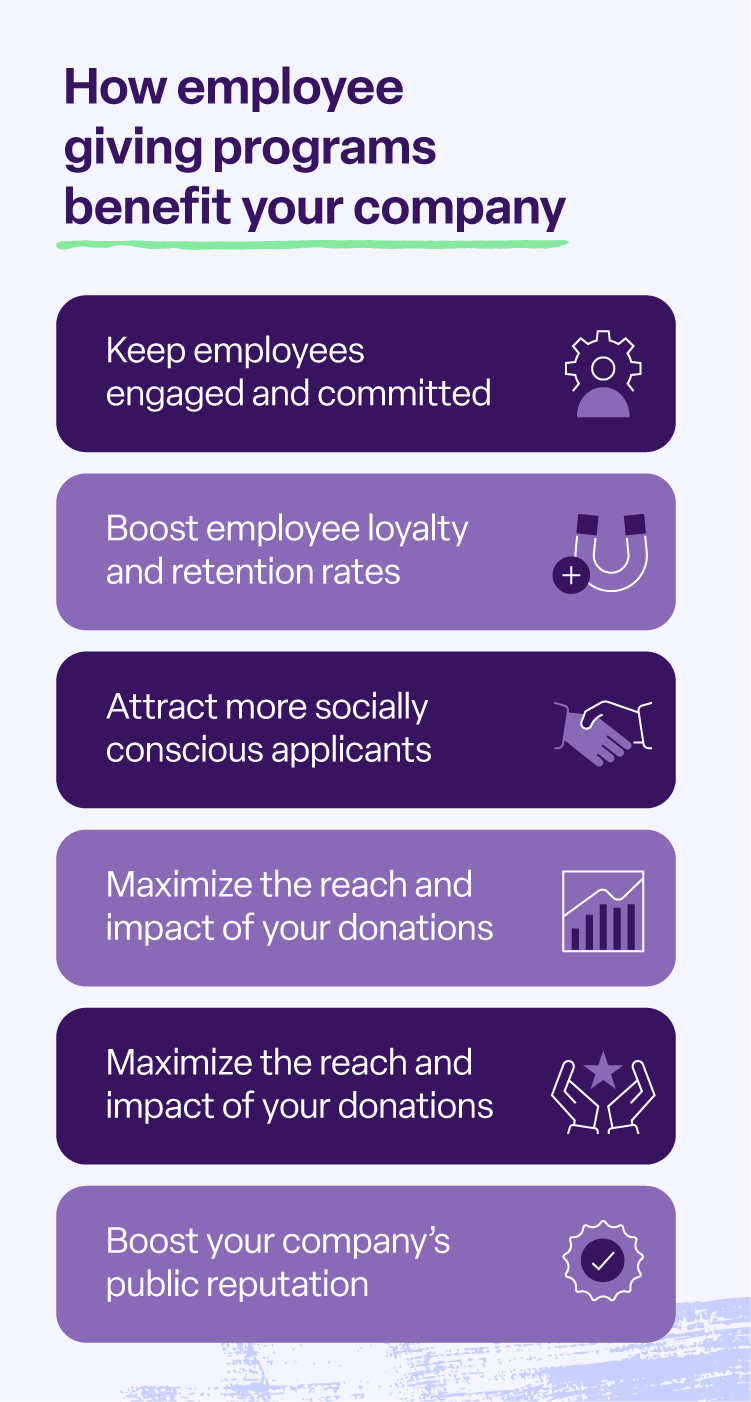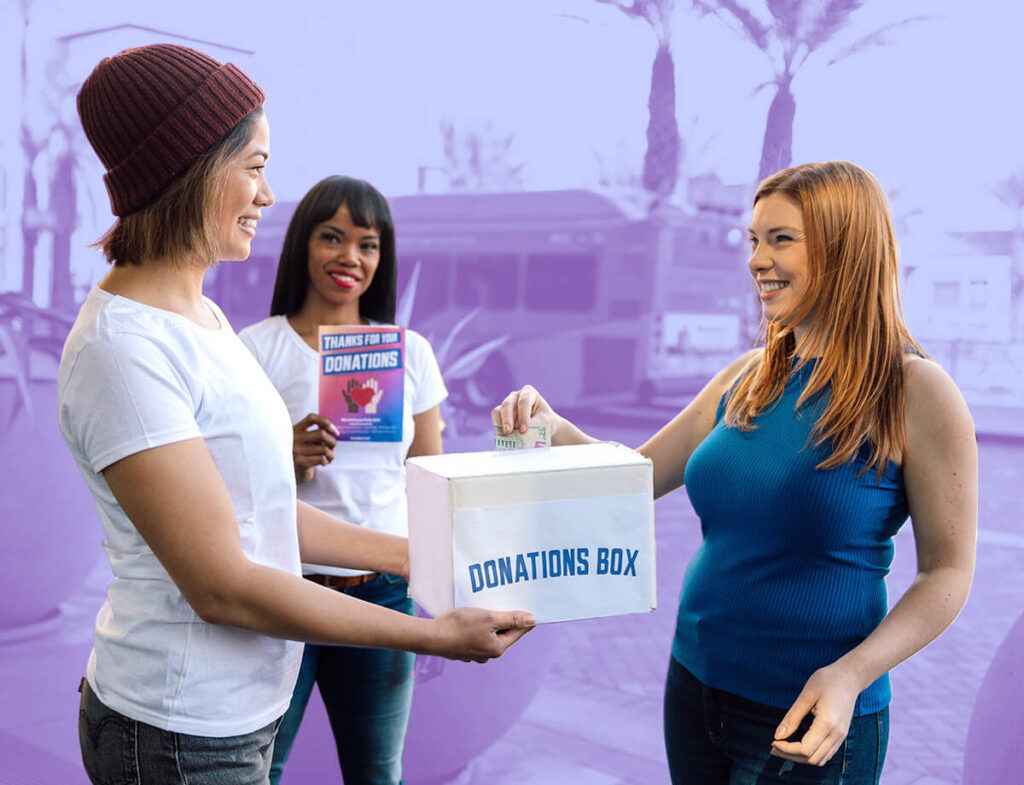Employee giving guide: Setting up and incentivizing workplace giving programs

Corporate philanthropy, especially employee giving, is a well-established practice that shows your employees that you care and allows you to positively impact your community.
Investing in employee giving via the right corporate social responsibility software allows employees to feel connected to your corporation and more engaged in their work. In fact, 79% of employees who volunteer through their workplaces report higher job satisfaction.
One survey found that 58% of companies believe workplace giving programs are important for engagement and retention, suggesting that philanthropic initiatives can help attract and retain your best team members. By starting an employee giving program, your company can create real change alongside your employees.
This guide will explore the basics of employee giving, how to start a program, and tips for making the most of it.
What is employee giving?
Employee giving, staff giving, or workplace giving is a CSR strategy that lets employees support nonprofit organizations through donations, fundraising, and volunteering.
Employees and employers work together to give time and money to worthwhile causes, empowering employees to participate in and shape their employer’s corporate philanthropy strategy.
Companies may have one or several employee giving programs, depending on their budget and employees’ interest levels. In every program, employees should actively participate by choosing the causes they support, initiating the giving process, and providing input about ways to improve the program.

Benefits of employee giving programs
Over 80% of employees want to work for socially responsible companies, and even more want their company to share their values. A few core business benefits of employee giving include:
- Boost employee engagement: Show employees that you share their values, increasing their trust in your business by improving employee giving.
- Raise employee retention levels: Employees who believe in their company’s values are often more engaged, productive, and committed; participants are also 57% less likely to leave their jobs.
- Appeal to like-minded applicants: By attracting people who share your company values, you can foster a sense of community among employees and maximize your impact.
- Generate more impact on a variety of causes: Employee-led giving programs can help your company make a broader impact with corporate funding and ensure your efforts resonate with employees.
- Improve charitable contributions and impact: When you know which causes your employees care about, you can align future programs with their interests to help boost participation.
- Increase public trust in your company: You can improve customer relationships and your business’s reputation in your community by making donations and reporting on your company’s impact with the help of a charitable giving platform.
5 core types of employee giving programs
While any corporate philanthropy program that lets employees take the lead can be considered employee giving, the most common giving programs include the following.
1. Matching gifts
A matching gift program is one of the simplest and most effective ways to boost your company’s charitable activity and encourage employee giving. Companies can match their employees’ donations to nonprofits, usually at a 1:1 or 2:1 ratio.
These programs are popular among employees and businesses alike. Employees appreciate this program because they can choose causes they want to support and double their personal impact. The freedom to donate to causes that align with their values empowers employees and keeps them engaged, contributing to higher levels of job satisfaction.
Businesses that match donations stand to benefit from a more engaged workforce, a positive public image, and tax advantages. With more than half of Fortune 500 companies having a successful matching gift policy, matching gift revenue accounts for $2 billion in charitable donations per year.
Work with your CSR team to create your company’s matching gift policy, determining details like:
- Matching ratio (most companies have a 1:1 or 2:1 match policy).
- Minimum and maximum donations you’ll match.
- Special promotions, such as a higher match on GivingTuesday or during the holiday season.
- The application process, including what information employees need to report to have their match approved.
2. Dollars for doers
Dollars for Doers programs, also known as volunteer grants, let employees give their time to a nonprofit they care about — then your company matches their effort with a donation.
Typically, companies give grants based on the number of hours an individual employee volunteers; you might donate $100 to a nonprofit after an employee volunteers for 25 hours, or you might give $10 for each hour of volunteering up to a certain amount.
Volunteer grant programs help nonprofits recruit volunteers and raise more for their mission while allowing your employees to financially support their favorite organizations without using any of their own money.
3. Payroll giving
With a payroll giving program, you can simplify the donation process for your employees and promote regular, sustainable giving. Employees choose one or more nonprofits they want to support, then define an amount they want to donate directly from their paycheck as a one-time donation or on a recurring basis.
For nonprofits, payroll giving provides them with a reliable and consistent source of revenue, allowing them to develop a plan for how to strategically use those funds over a period of time.
4. Charitable spending accounts (CSAs)
A CSA contains an amount of money set aside for each employee to give to charitable causes each year. For example, you could give new hires $100 to donate within the first calendar year of their employment or allocate $500 to each full-time employee for donations.
Unlike matching gift programs, charitable spending accounts (CSAs) don’t require employees to make a donation to get access to company funds. Instead, your company provides your employees with a set amount of money upfront to donate each year. CSAs are an equitable giving program, allowing employees to get involved in philanthropy even if they would not be able to contribute on their own.
5. Annual employee giving campaigns
Annual giving campaigns involve a concerted effort to encourage employees to give during a specific time frame. You could:
- Host a team giving challenge for employees.
- Donate to Feeding America during Hunger Action Month.
- Support LGBTQIA+ orgs during Pride month.
- Plan a seasonal campaign that invites employees to tap into the holiday giving spirit.
This allows your company and employees to build long-term mutually beneficial partnerships with these nonprofits. As a result, you can better understand their evolving needs and tailor programs to meet them.
How to create an impactful employee giving program
Now that you understand your options, let’s explore the steps to starting a successful workplace giving program at your company.
Step 1. Align employee giving with your company values
Instead of choosing programs solely based on your budget or the latest workplace giving trends, start by finding programs that align with your company’s values. Show employees that your new employee giving program is sincere and worth their involvement by staying true to your philanthropic purpose and the values that drew them to your company.
Make sure that these programs align with your employees’ interests, too. Ask yourself if each proposed program is something a majority of employees would be excited to participate in. If you’re not sure, send out a quick survey to gauge employees’ interest levels.
Step 2. Set program guidelines
Once you’ve chosen your programs, determine guidelines for each one. While guidelines will vary slightly from program to program, you should outline basic restrictions like the type of nonprofits eligible for corporate funding and how much your company can donate.
You should establish the following:
- Donation matching minimums and maximums
- Employee eligibility
- Submission deadlines
- Request and approval processes
- Special promotions
Step 3. Encourage participation in your new employee giving program
Announce the program to all your employees once you’ve ironed out the details. Schedule an informational meeting or send out documentation about the program’s guidelines, its purpose, and how it benefits your employees. Be prepared to answer questions and note any initial feedback that team members have.
Encouraging participation early on is a vital part of any employee engagement strategy. Empower employees to start giving right away, and highlight those who participate early. Send periodic emails about how the program is going and what you’ve accomplished to keep your employees engaged and motivated to give.
Step 4. Monitor the program’s results over time
Measure the success of your new employee giving program by selecting outcomes and key performance indicators to measure, such as total funds donated and hours volunteered. This information will help you improve the program, boost employee participation, and demonstrate your company’s philanthropic impact to stakeholders.
Use an employee giving platform to simplify this process and ensure that you’re tracking important impact metrics. With an intuitive CSR platform, you can quickly gauge your program’s impact using automated and custom dashboards.
For instance, this example from Bonterra’s Strategic Philanthropy solution shows the total amounts donated and matched by a company based on cause area:
7 strategies to incentivize employee giving participation
Implementing an employee giving program at your organization is a great first step towards a more engaged workforce.
Maximize the benefits of your corporate philanthropy program by using the following strategies to inspire more employees to get involved and truly maximize your program’s potential.
1. Gather and implement employee feedback
The best way to ensure your employees are excited about your program is to involve them in the decision-making process. While you may delegate the bulk of the operations to management or the CSR committee, ask for team members’ input to show them you value their opinions.
Encourage involvement and program satisfaction by asking about:
- Which charities they want to support.
- Which fundraising events they’d like to participate in.
- What type of gifts they want to donate (monetary or in-kind).
- What would make your employee giving program more appealing.
Take the feedback process further by conducting employee interviews about the program, allowing team members to share more in-depth feedback and reflect on their impact.
2. Incentivize giving with rewards and recognition
Thank your employees for participating with special perks to rally your workforce and improve morale. One way to reward your employees is by turning fundraisers into friendly peer-to-peer competitions and offering prizes to the highest earners.
Consider offering one or more of the following incentives for employees who go above and beyond in engaging with your program:
- Offer additional vacation time, such as special volunteer paid time off days.
- Use leaderboards to recognize and reward top donors and volunteers.
- Plan a team outing to celebrate participants’ efforts and highlight the impact they’ve had.
- Send gift cards or branded merchandise to all team members who participate in employee giving.
Once employees get involved in your CSR initiatives, remember to express your sincere gratitude to those who participate. Take the time to celebrate your team, and they’ll likely increase their future involvement.
While many employees will want to participate in workplace giving solely to contribute to charitable causes, it doesn’t hurt to offer additional motivation. See if these incentives resonate with your team, or tailor them to your workforce.
3. Empower employees to take initiative
When building out your CSR strategy, don’t leave your employees out of the planning process. Find out which programs your employees liked the most and which ones fell flat so you can build stronger, more impactful employee-centered programs next time.
Listen to your employees’ ideas and encourage them to take the lead. This will inspire further involvement with philanthropy and show other team members that the possibilities for giving are endless.
Whether you’re starting an employee volunteer program or introducing an employer match, encourage employees to make purpose-driven changes and invite them to propose additional modifications that support your goals.
4. Accept multiple types of donations
Not every employee will be engaged in the same way. Providing different ways for your team to participate can increase interest and effort.
You can offer giving options for multiple causes and organizations or through multiple different programs such as volunteer grants or matching gifts. Work out various donation possibilities with your nonprofit partner to empower more of your employees to contribute.
Monetary contributions are useful, but other types of charitable contributions include:
- In-kind gifts: Encourage employees to donate supplies, resources, or professional services instead of monetary donations; your employees may donate school supplies or offer to create new graphics for a nonprofit.
- Volunteer time: Allow your team to use their PTO for a good cause by implementing a volunteer time off policy. You can maximize your impact by organizing a company-wide volunteering outing.
5. Clarify your company’s values
Show employees that your CSR program is sincere and worth their involvement by choosing a philanthropic purpose that aligns with your company’s values and taking steps to demonstrate your commitment. You can accomplish this by:
- Adding a social responsibility pledge clause to your business’ bylaws
- Creating a CSR committee
- Hiring employees who share your values
Selecting socially conscious candidates and formalizing your company’s values can help you build a culture at your business that values giving.
6. Make it easy to participate
Simplifying participation will encourage more employees to join. Outline clear instructions for getting involved and simplify donating through automatic payroll deductions, credit card giving, or donation drives. If you make it easier for employees to donate, they will be more likely to do so, resulting in more engaged employees.
7. Encourage local giving
Giving back to the local community is a great way for employees to feel connected to their work and the greater community.
Banks often implement local giving campaigns to support their communities and capture CRA service credits. Other businesses can engage with local organizations to strengthen relationships with customers, vendors, and employees.
Examples of successful giving programs
Among Gen Z employees, 90% believe that companies should take social and environmental action, and up to 71% of employees specifically say it’s important that their employer supports giving and volunteering programs.
Employee giving programs can take different shapes depending on the company’s goals and employees’ values. This kind of workplace philanthropy is often tailored to an organization, but some successful programs include:
- Soros Fund Management offers a 2:1 donation matching program of up to $100,000 for full-time employees.
- Nestle USA allows employees to donate the equivalent of one day’s pay to sponsor educational organizations. Nestle matches the donation and provides two additional days of paid time off.
- Apple will donate $25 to the nonprofit of an employee’s choosing for every hour they spend volunteering.
- BP allocates $300 every year for each employee to donate to a nonprofit of their choosing.
- RealNetworks offers a 1:1 donation matching program of up to $10,000 a year and a $500 grant after five years of employment for each employee to donate to a nonprofit.
Embracing the power of employee giving
Employee giving initiatives have the power to create real community impact while engaging employees, encouraging them to become CSR champions, and empowering them to take philanthropy a step further. When your company embraces employee-led giving, you can make a measurable difference together.
Engage your workforce by investing in employee giving software to simplify how you manage your programs, track donations, and coordinate volunteer activities.
You can customize your programs to align with your corporation’s values and philanthropic goals, choosing nonprofit organizations and causes that your employees care about. Plus, you’ll be able to track the donations made through your programs, which are often tax-deductible, making it easier to declare during the next tax season.
Whether you’re just getting started with a new program or ready to optimize an existing one, Bonterra can help you simplify program management, maximize your impact, and increase employee participation.
Work with Bonterra



